 Handbook for Bristol Exhibition
Handbook for Bristol Exhibition Handbook for Ilford Exhibition
Handbook for Ilford Exhibition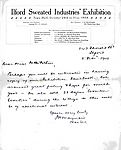 Ilford organiser's letter to Mary
Ilford organiser's letter to Mary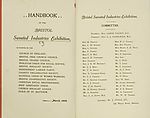 Bristol Exhibition Committee and Supporters
Bristol Exhibition Committee and Supporters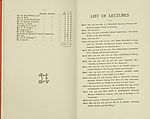 Bristol Exhibition List of Lectures
Bristol Exhibition List of Lectures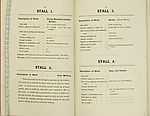 Four of the stalls at the Bristol Exhibition
Four of the stalls at the Bristol Exhibition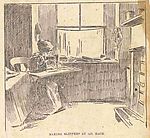 Making Slippers
Making Slippers Shirt Making
Shirt Making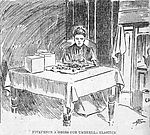 Preparing Umbrella Elastics
Preparing Umbrella Elastics Report of Margaret Macmillan's Lecture
Report of Margaret Macmillan's Lecture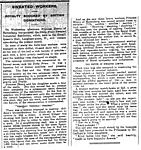 Express and Star, May 3rd 1906
Express and Star, May 3rd 1906

The issue of sweated labour was one of the most intractable social problems of the nineteenth and early twentieth centuries. Sweating was characterized by starvation wages, excessively long hours and insanitary working conditions. The failure of reformers to agree on the best way to deal with it, and the decline in public concern with social ills as a consequence of the Boer War, resulted in a downturn of interest in the plight of sweated workers. Renewed pressure to eradicate sweating came in 1906.
The shift in opinion came about when a number of factors came together for the first time. Information on wage levels, including low pay, became available in that year. A Liberal government was elected, which saw the arrival in parliament of several key figures, who were sympathetic to the plight of the low paid. In Germany in 1904 and 1906 there had been exhibitions of products made by homeworkers under oppressive conditions. Their success had an influence in England. George Cadbury, owner of the Daily News Newspaper, was persuaded not only to use the pages of his newspaper to expose sweating, but also to finance a sensational sweated industries exhibition. He compensated the workers attending for loss of earnings, and guaranteed to support any who were victimized for taking part.
The exhibition was opened by Princess Beatrice, the King’s youngest sister, and was staged in the heart of London’s West End. Concentrating on work carried out in the home, the exhibition lasted one month and was visited by over 30,000 people. The exhibition brought the public, especially the very wealthy, into personal contact with sweated workers for the first time. A series of lectures on the problems of sweating, and possible solutions, were given by authorities on the subject. They included James Ramsay MacDonald, Mary Macarthur, Leo Chiozza Money and George Bernard Shaw.
There were twenty five stalls at which forty-five workers, mainly women, demonstrated their skills, and answered the visitors’ questions. The family budgets of the workers were also on display, along with the goods they had made and the wages they earned. Visitors were taken aback by the discovery that the going rate for a gross (144) of matchboxes was tuppence farthing (1p), with workers having to find their own paste, and that 5d (2p) was commonly paid for the entire making of a full-sized woman’s skirt. The Women’s Trade Union Review reported that visitors were also astonished “that cigarette-making, the beading of ladies’ shoes, the stitching of gloves, chainmaking and the manufacture of hosiery, jewel-cases, tennis-balls, belts, ties, furniture, brushes, and saddlery were all homework trades, in which a twelve to sixteen hour day brought in, on average, earnings of 5s (25p) to 7s (35p) a week."
Before the exhibition the perception had been that sweating was confined to the “cheap and nasty” end of the market. Visitors were shocked to find that low pay and poor conditions were to be found at the bottom end of virtually every occupation, and that many expensively priced goods had, at some point, been handled by sweated labour. A dress could have been made by a well paid seamstress in a light and airy workroom, while the buttons and trimmings were probably produced by a sweated worker. Wedding cakes manufactured in hygienic conditions were likely to be packed in attractive boxes glued together in a disease-ridden tenement.
The results of the exhibition were profound, and the impact was sustained when similar exhibitions were subsequently staged in major towns around the country. Some were still being run as late as 1914. Some of the pages from the handbooks of the Bristol and Ilford exhibitions have been included here to provide contemporaneous information. The problem of sweating, which had previously been the concern of a limited number of people, became the centre of public conversation. The level of awareness raised by the 1906 exhibition led directly to the establishment of a powerful all-party pressure group, the National Anti-Sweating League. It had many influential members, including Mary Macarthur, J.J. Mallon, R.H.Tawney and George Cadbury, and was dedicated to ending low pay and establishing a minimum wage.
Rollover the captions in the box to see the available images in thumbnail format, click the caption to see the full-size image
| Reference: | 718 |
| Keywords: | |
| Archive Ref: | |
| Updated: | Thu 12 Jul 2007 - 1 |
| Interpretation written by | Barbara Harris |
| Author's organisation | |
| Organisation's website | |
| Source | Express and Star, May 3rd, 1906 |
| Source | Sheila Blackburn - Historical Journal, 34, 1 (1991) pp. 43 - 64 |
| Source | TUC archive - examples from exhibition handbooks |